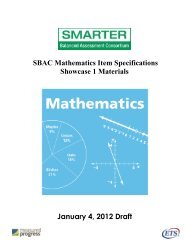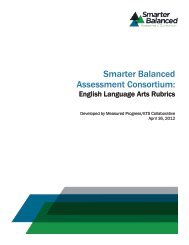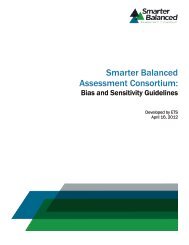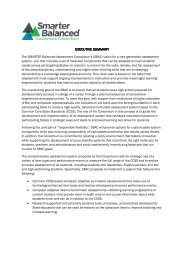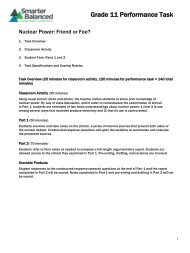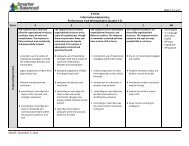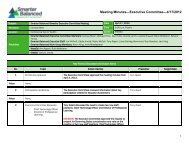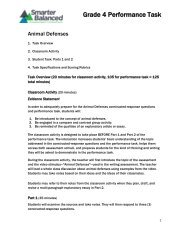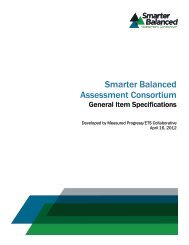Content Specifications for the Summative Assessment of the ...
Content Specifications for the Summative Assessment of the ...
Content Specifications for the Summative Assessment of the ...
You also want an ePaper? Increase the reach of your titles
YUMPU automatically turns print PDFs into web optimized ePapers that Google loves.
TABLE OF CONTENTS<br />
Page<br />
Introduction and Background<br />
7<br />
<br />
<br />
<br />
<br />
<br />
<br />
Using This Document<br />
Purpose <strong>of</strong> <strong>the</strong> <strong>Content</strong> <strong>Specifications</strong><br />
Consortium Theory <strong>of</strong> Action <strong>for</strong> <strong>Assessment</strong> Systems<br />
Accessibility to <strong>Content</strong> Standards and <strong>Assessment</strong>s<br />
<strong>Content</strong> Mapping and <strong>Content</strong> <strong>Specifications</strong> <strong>for</strong> <strong>Assessment</strong> Design<br />
Evidence-based Design<br />
Part I – Development Process <strong>for</strong> <strong>the</strong> Major Claims and <strong>Assessment</strong> Targets 15<br />
Part II – <strong>Content</strong> <strong>Specifications</strong>: Mapping <strong>Assessment</strong> Targets to Standards<br />
21<br />
<br />
<br />
<br />
<br />
<br />
Defining <strong>Assessment</strong> Claims and Relevant and Sufficient Evidence<br />
<strong>Assessment</strong> Targets<br />
Proposed Reporting Categories<br />
O<strong>the</strong>r <strong>Assessment</strong> Notes<br />
Summary <strong>of</strong> Overall Test Design <strong>for</strong> ELA/ Literacy<br />
Part III – Claims, Rationale, Evidence, <strong>Assessment</strong> Targets, Proposed Reporting<br />
Categories<br />
26<br />
<br />
<br />
<br />
<br />
<br />
Overall Claim – Students can demonstrate [progress toward (Gr. 3-8)] college and<br />
career readiness in English language arts and literacy (p. 26)<br />
Claim #1 – Students can read closely and analytically to comprehend a range <strong>of</strong><br />
increasingly complex literary and in<strong>for</strong>mational texts. (p. 29)<br />
Claim #2 – Students can produce effective and well-grounded writing <strong>for</strong> a range <strong>of</strong><br />
purposes and audiences. (p. 45)<br />
Claim #3 – Students can employ effective speaking and listening skills <strong>for</strong> a range <strong>of</strong><br />
purposes and audiences. (p. 56)<br />
Claim #4 – Students can engage in research / inquiry to investigate topics, and to<br />
analyze, integrate, and present in<strong>for</strong>mation. (p. 63)<br />
References 75<br />
Appendices<br />
Appendix A: Cognitive Rigor Matrix/Depth <strong>of</strong> Knowledge (p. 79)<br />
Appendix B: Grade Level Tables <strong>for</strong> Reading <strong>Assessment</strong> Targets (p. 80)<br />
Appendix C: Tools <strong>for</strong> Examining Text Complexity (p. 98)<br />
79<br />
6



